The ASRock B450 Gaming ITX/ac and B450 Gaming K4 Motherboard Reviews
by Gavin Bonshor on July 31, 2018 10:00 AM ESTSystem Performance
Not all motherboards are created equal. On the face of it, they should all perform the same and differ only in the functionality they provide - however, this is not the case. The obvious pointers are power consumption, but also the ability for the manufacturer to optimize USB speed, audio quality (based on audio codec), POST time and latency. This can come down to manufacturing process and prowess, so these are tested.
Power Consumption
Power consumption was tested on the system while in a single ASUS GTX 980 GPU configuration with a wall meter connected to the Thermaltake 1200W power supply. This power supply has ~75% efficiency > 50W, and 90%+ efficiency at 250W, suitable for both idle and multi-GPU loading. This method of power reading allows us to compare the power management of the UEFI and the board to supply components with power under load, and includes typical PSU losses due to efficiency. These are the real world values that consumers may expect from a typical system (minus the monitor) using this motherboard.
While this method for power measurement may not be ideal, and you feel these numbers are not representative due to the high wattage power supply being used (we use the same PSU to remain consistent over a series of reviews, and the fact that some boards on our test bed get tested with three or four high powered GPUs), the important point to take away is the relationship between the numbers. These boards are all under the same conditions, and thus the differences between them should be easy to spot.
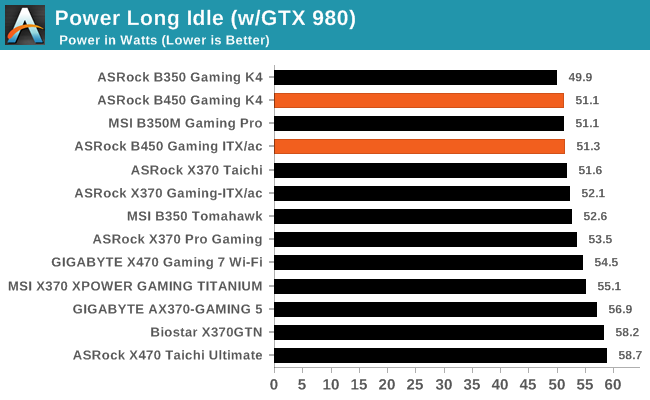
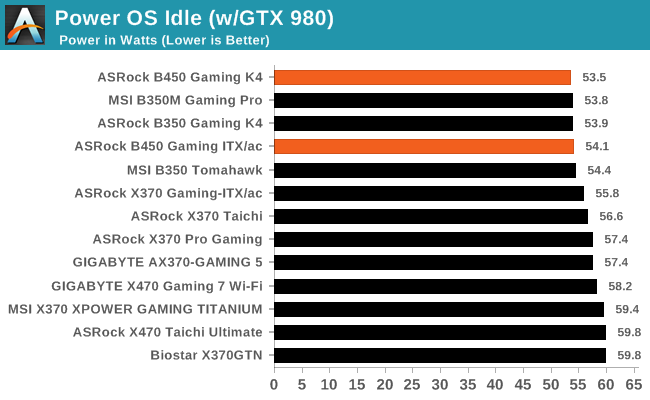
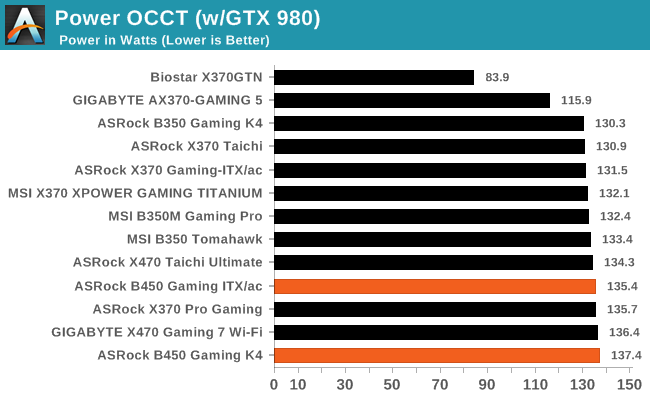
Both the B450 Gaming ITX/ac and B450 Gaming K4 motherboards perform very well at both of the test idle power states, but things go a little awry for the B450 Gaming K4 at full load with the highest power draw so far. From the previous B350 Gaming K4 board we tested, the B450 managed to somehow gain an additional 7 W of power at load which isn't all that much in the grand scheme of things, but it's still an increase to take note of.
Non-UEFI POST Time
Different motherboards have different POST sequences before an operating system is initialized. A lot of this is dependent on the board itself, and POST boot time is determined by the controllers on board (and the sequence of how those extras are organized). As part of our testing, we look at the POST Boot Time using a stopwatch. This is the time from pressing the ON button on the computer to when Windows starts loading. (We discount Windows loading as it is highly variable given Windows specific features.)
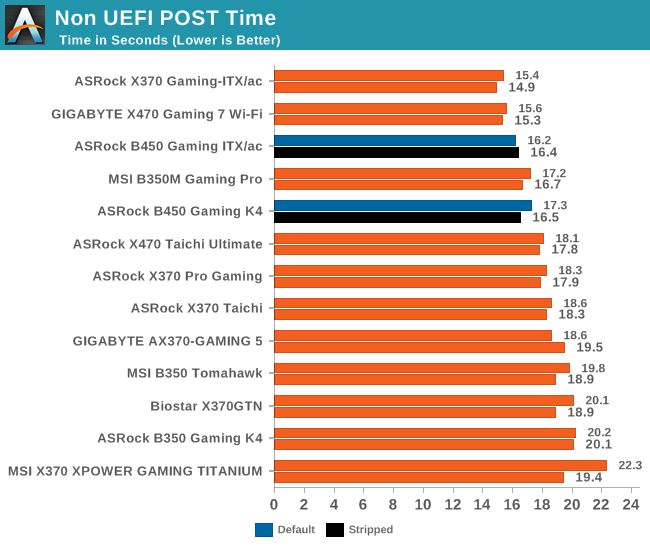
Three of the top five boards in our POST time are from ASRock, which shows a reliable and efficient POST sequence. Both the B450 Gaming K4 and Gaming ITX/ac make the cut and the ATX sized B450 board even manages to shave over a second off POSTing time with some onboard controllers disabled.
Rightmark Audio Analyzer 6.2.5
Rightmark:AA indicates how well the sound system is built and isolated from electrical interference (either internally or externally). For this test we connect the Line Out to the Line In using a short six inch 3.5mm to 3.5mm high-quality jack, turn the OS speaker volume to 100%, and run the Rightmark default test suite at 192 kHz, 24-bit. The OS is tuned to 192 kHz/24-bit input and output, and the Line-In volume is adjusted until we have the best RMAA value in the mini-pretest. We look specifically at the Dynamic Range of the audio codec used on the rear panel of the board.
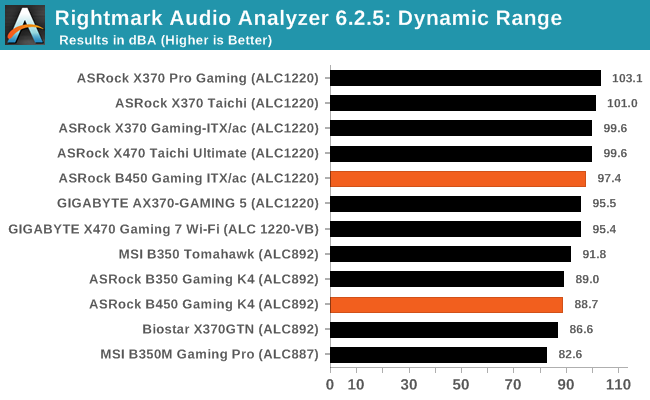
The Realtek ALC1220 is one of the best performing and most widely used premium audio codec used on medium to high-end motherboards across the majority of chipsets, so the B450 Gaming ITX/ac puts in a good showing because of this. The B450 Gaming K4 makes use of a slightly lower grade, but cheaper Realtek ALC892 codec and the results reflect this.
DPC Latency
Deferred Procedure Call latency is a way in which Windows handles interrupt servicing. In order to wait for a processor to acknowledge the request, the system will queue all interrupt requests by priority. Critical interrupts will be handled as soon as possible, whereas lesser priority requests such as audio will be further down the line. If the audio device requires data, it will have to wait until the request is processed before the buffer is filled.
If the device drivers of higher priority components in a system are poorly implemented, this can cause delays in request scheduling and process time. This can lead to an empty audio buffer and characteristic audible pauses, pops and clicks. The DPC latency checker measures how much time is taken processing DPCs from driver invocation. The lower the value will result in better audio transfer at smaller buffer sizes. Results are measured in microseconds.
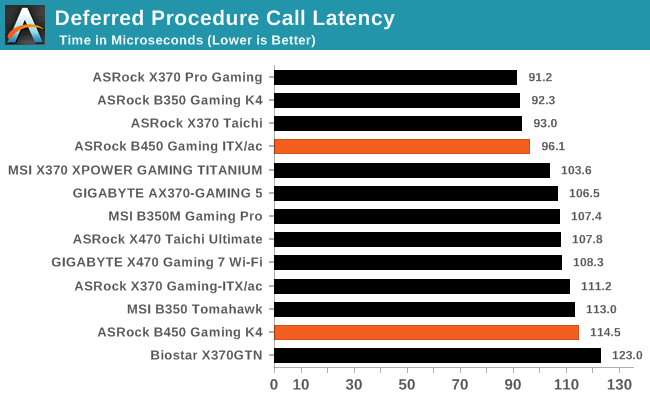
None of the AM4 motherboards tested thus far has been optimized for DPC latency, but ASRock does consistently post the best scores with the B450 Gaming K4 being one of the worst tested so far. The B450 Gaming ITX/ac however sits towards the top of the pack.










29 Comments
View All Comments
Flappergast - Tuesday, July 31, 2018 - link
Again I’m looking at the msi b350 just kicking ass. Can anyone tell me why?mapesdhs - Tuesday, July 31, 2018 - link
"... so while technically there is a 6+3 phase count there, ASRock’s marketing is somewhat misleading."Is this by any chance the same issue that Buildzoid talked about re a particular Gigabyte board?...
https://www.youtube.com/watch?v=3IjWCOXSuKU
ipkh - Tuesday, July 31, 2018 - link
There is no doubler chip on the board. Linking/Shorting is not the same and shouldn't be conflated with what a doubler actually does.ZolaIII - Wednesday, August 1, 2018 - link
Why on earth would you pair this with an old first gen Ryzen? Long anticipated chipset to drive second gen Ryzen 5's... Very disappointing review.plonk420 - Wednesday, August 1, 2018 - link
thanks for the K4's VRMs!walmart32 - Saturday, August 4, 2018 - link
Please tell us about https://www.walmartnearme.co/Dug - Monday, August 6, 2018 - link
Can we please get some relevant information on motherboards like in the old days of Anandtech? Hard drive speed tests, lan and wireless tests, sound tests, memory tests, an analysis on why fps is so much lower. You know, the reasons people look at getting one motherboard over another. Plus get a new processor in there. You are using a new generation motherboard.Langers - Thursday, August 9, 2018 - link
I'm planning on building a SFF PC with the ITX B450 board and a Ryzen 5 2400G. I've not built a PC for about 8 years so I'm a bit rusty so any help is appreciated. Can anyone recommend which RAM to use? I'd like to go as fast as is supported without overclocking (to start with).Cheers
Langers
bjocan - Saturday, August 25, 2018 - link
A thing that was missed in the article when comparing the Gaming B450-ITX/ac to the X470 version of the same board was that the later has Bluetooth 5.0 while former only has Bluetooth 4.2. Could be significant to some buyers.